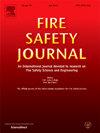在PMMA立方体的边缘加速引燃
IF 3.4
3区 工程技术
Q2 ENGINEERING, CIVIL
引用次数: 0
摘要
在固体边缘上点火比在平面上更容易,具有更高的火灾危险。为了揭示这种独特的点火机制,建立了一个能够发射两个水平垂直热流的装置,定义为q1和q2,在PMMA立方体的垂直边缘进行引燃试验。设计两组检验:(1)q1 = q2,记为SET1;(2) q1不变,q2变化,记为SET2。为了比较,还进行了垂直样品的1D点火试验。收集了边缘和表面温度、质量损失率(MLR)和点火时间(tig)。结果表明:与一维点火相比,边缘点火速度加快;数值求解忽略了边缘回归,得到了实测的表面温度,但高估了边缘温度。由于同样的原因,SET1和SET2的实验mlr和tig无法通过数值模型准确估计。SET1和SET2的临界MLR随热流密度的降低而降低,但在1D点火过程中保持不变。临界温度为656.4±3.5 K。SET1中tig-0.5与热通量呈线性关系,而SET2中tig-0.5不存在线性关系。利用实测模型和解析模型,估算了PMMA的热惯量和临界热流密度。本文章由计算机程序翻译,如有差异,请以英文原文为准。
Accelerated piloted ignition on an edge of a PMMA cube
Ignition on solid edges is easier compared to that on flat surfaces, featuring higher fire hazard. To reveal this unique ignition mechanism, an apparatus capable of emitting two horizontal perpendicular heat fluxes, defined as q1 and q2, was built to conduct piloted ignition tests on vertical edges of PMMA cubes. Two sets of tests were designed: (1) q1 = q2, denoted as SET1; (2) q1 remained unchanged while q2 varied, denoted as SET2. For comparison, 1D ignition tests of vertical samples were also performed. Edge and surface temperatures, mass loss rate (MLR), and ignition time (tig) were collected. Results showed that ignition on edge was accelerated compared to 1D ignition. The numerical solver neglecting edge regression captured measured surface temperature but overpredicted edge temperature. Attributed by the same reason, experimental MLRs and tig of SET1 and SET2 cannot be accurately estimated by the numerical model. Critical MLR in SET1 and SET2 declined with lower heat flux but remained unchanged in 1D ignition. Critical temperature was identified to be 656.4 ± 3.5 K. In SET1, tig-0.5 linearly depended on heat flux, whereas no such linearity existed in SET2. Using measured tig and analytical models, thermal inertia of PMMA and critical heat flux were estimated.
求助全文
通过发布文献求助,成功后即可免费获取论文全文。
去求助
来源期刊

Fire Safety Journal
工程技术-材料科学:综合
CiteScore
5.70
自引率
9.70%
发文量
153
审稿时长
60 days
期刊介绍:
Fire Safety Journal is the leading publication dealing with all aspects of fire safety engineering. Its scope is purposefully wide, as it is deemed important to encourage papers from all sources within this multidisciplinary subject, thus providing a forum for its further development as a distinct engineering discipline. This is an essential step towards gaining a status equal to that enjoyed by the other engineering disciplines.
 求助内容:
求助内容: 应助结果提醒方式:
应助结果提醒方式:


